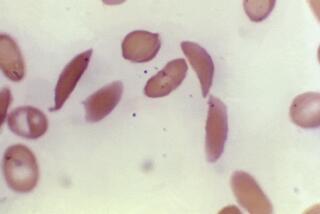Gene Therapy Trials in the Works to Treat Hereditary Blood Diseases
Scientists in New York have developed a gene therapy they say may cure two pervasive blood disorders, and the first round of human trials is expected to begin within six months.
Sickle cell disease and thalassemia are related genetic disorders typified by red blood cells that are incapable of effectively transporting oxygen. The diseases affect tens of thousands of people worldwide, and can prove fatal.
Scientists at Memorial Sloan-Kettering Cancer Center in Manhattan reported this week in an online edition of Nature Biotechnology that they have developed a form of gene therapy that targets stem cells and restores effective oxygen delivery.
The report focuses on sickle cell disease, but the team has completed preliminary work on thalassemia and is expected to begin clinical trials by summer.
âThe goal here is ambitious because the purpose of this is to achieve cures for both diseases,â said Dr. Michel Sadelain, the studyâs lead investigator.
Gene therapy is the technique in which a healthy new gene is incorporated into patientsâ cells to correct a debilitating defect.
Patients with thalassemia and sickle cell disease are hobbled by a defective form of globin, the oxygen-carrying compound in red blood cells. The researchers will use a killed lentivirus -- HIV-1 -- to ferry healthy globin genes into stem cells. HIV-1 was selected for the task because of its keen ability to integrate into the chromosomes of cells.
Bone marrow transplants are now used to treat thalassemia and sickle cell disease, but finding appropriate donors can be difficult, Sadelain said. Even when a donor is found, patients still face the possibility that their immune system will reject the transplant.
Gene therapy offers a way to infuse patients with their own cells. The process begins with stem cells, which are produced in the bone marrow and collected from a patientâs blood. The cells are then cultured under sterile laboratory conditions, and healthy genes are transferred into the cellsâ chromosomes with the help of the killed HIV-1.
Before the cells are reinfused, patients are given a medication to tamp down their immune system and boost the likelihood that the newly altered stem cells will produce a healthy blood supply. The procedure is virtually painless.






